The Athletics Museum and The Hockey Museum were lucky enough to sit down recently with Team England and GB athlete and hockey player Joy Crowther (nee Smith) to hear her memories of a century in sport as she celebrates her 100th birthday.
Beginnings
Joy Smith was born into a sporting family in West Ealing London in August 1925. Her grandfather William Winterbottom had captained the Northern Counties Rugby Team in 1886, her father’s brothers all flew planes and rode motorbikes, and her mother Alice Worrall-Winterbottom had played hockey for Hyperion Ladies in the early 1920s, before Joy was born. At school sports days her mother would inevitably win the visitors races, kicking off her shoes, tucking up her skirts and leaving everyone else standing. As a child Joy was encouraged by her mother to do anything sporty, be it high jumping in the back garden over the clothes line, or practicing catching with a ball against a wall.
On going to Ickenham Girls’ School at age 11, Joy played hockey, cricket and tennis and was proficient in all. The advent of War in 1939 saw Joy and her family move from London to the Northwest – her father was a civil servant and needed to be near Harrogate – returning to London in 1941. Joy finished her schooling during the war, focusing on the sciences and in 1943 moved to Devon to take a job on an estate of a retired Colonel, looking after the cows, horses and pigs, moving hay, driving a caterpillar tractor, learning how to build a hay rick, and how to thatch. She earnt 48 shillings per week for 48 hours work and lived above the stables, sharing with other girls. Joy returned to her parents’ house in London in 1944 after a bout of appendicitis and continued to work on farms closer to the capital.
There had been no sport during the War but when things started up again, ever the keen sports woman, Joy joined Uxbridge Ladies Hockey Club, getting into the first team straight away as a left wing – her speed was a definite boon.
The 1948 Olympic Games, held in London after a twelve-year hiatus caused by the War had a big impact on Joy. Now 22 year old and training to be a teacher, Joy recalls going to watch Olympic athletics events at White City in any spare time that she could find – usually the evening sessions – and witnessing Fanny Blankers-Koen “the Flying Dutch Woman” win the 100m, 200m, 80m hurdles and relay. Only a rule limiting female athletes to three individual events prevented Blankers-Koen from competing for more medals. Witnessing Blankers-Koen’s success in the 1948 Games inspired Joy to get better. She knew a teacher and coach who she thought might be able to help, this was Victor Sealy, who would go on to be an international coach and write the book Coaching for Track and Field Athletics. Both could see that she had speed, but as Victor pointed out, sprinters were 10 a penny. At 5’8 (172.5cm) Joy also possessed a height advantage over many other women athletes, and her years working on the land during the War had given her strength. Sealey suggested throwing.
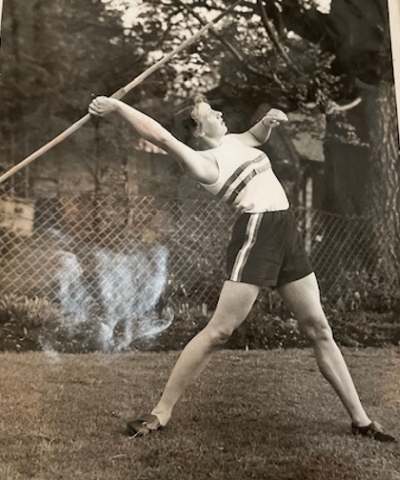
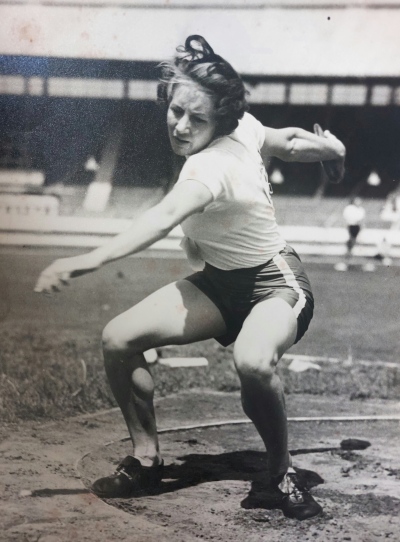
Joy recalls that there really were no facilities for field events:
as a young woman I had to go into a local field, cut a circle, and fill it with ashes from the neighbours’ hearths to have a practice circle. I had to go out with my wheelbarrow to collect up the cinders
Vic would come once a week to see how she was getting on. Knowing that the only way to compete was through a club, Joy joined Middlesex Ladies Athletics Club. “The club put you forward for competition. In order to progress you had to reach standard, and be awarded the standard medal, then they would put you forward for bigger competitions.”
In 1950 she won the Women’s Amateur Athletic Association Discus Championship with a mark of 108’ 4 ½ inches (33.03m) and was selected to represent England in two international matches, one against the Dutch team, the other against the French. “If you were selected to compete you won a badge and ribbons in red, white and blue badge. The badge was for your shirt, the ribbons for your shorts. You competed in your club shorts and shirts, sewing the ribbons and badges on.” Her parents bought her her international tracksuit, white with trousers, from Lilywhites in Oxford Circus.
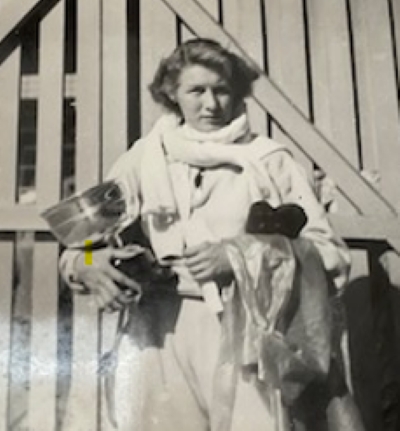
Image credit: Joy Crowther
International Athlete
England vs Holland – Amsterdam 1950
England sent a full team, men and women. Joy was selected for discus and also competed in the javelin. Her main recollection of this match was Fanny Blankers-Koen, star of the 1948 London Olympics being driven around the track in an open topped car with the local mayor prior to the match beginning so that the crowds could see her, such was her popularity.
Great Britain vs France 1950
The 1950 Great Britain vs France Match took place at the Stade Olympique de Colombes – the main venue of the 1924 Paris Olympics. It was a full international, with a mixed team of approximately 60 athletes. Joy shared a room with Sylvia Neeham, who would go on to represent England in discus at the 1958 British Empire and Commonwealth Games. Jack Crump stalwart athletics administrator was the Team Manager. Arthur Wint, RAF Pilot during the Second World War, and at the time a medical student at St Bartholomew’s Hospital London was captain, and Roger Bannister was among those on the team. Though GB’s women did very well, beating the French women in almost every event, the match overall was won by France.
On arrival at the match the team was led out in height order, Joy, standing at 5’8 (173cm) led out the women. In the discus, Joy was up against Micheline Ostermeyer who had won gold in the discus, shot put and high jump at the 1948 Olympics. It was not unusual for athletes to compete in more than one event; Joy was also listed for the javelin where she placed 4th and took part in the relay.
“There was good support, once we had done our event we would go and watch each other and cheer each other on.”
Things were not always plain sailing however – on the way to the Paris match, which the team travelled to by aeroplane, it turned out that the pole vault poles were too long to fit in the aircraft. In the end all of the seating along one side of the small aircraft was removed so that the two bamboo poles could lie on the floor along the length of the plane.
Festival of Britain
Alongside competition Joy did a lot of demonstration and coaching; “If you were part of a club you were sent off to coach, that’s just how it was.” As a trainee PE teacher Joy coached a lot of school children in London while part of Middlesex Ladies AC. She also became an attraction at the 1951 Festival of Britain, having been invited to give demonstrations of throwing events. For several days, Joy and a fellow male athlete were installed in a netted off area approximately the size of a tennis court to demonstrate shot put and discus to Festival goers.
Hockey
Alongside athletics Joy played hockey, initially for Uxbridge Ladies for four seasons, switching to Ealing Ladies HC after taking a position as Assistant PE Teacher at Ealing Grammar School. In 1953 she was invited to play for the South of England in 1953 in the Women’s Representative Hockey Team against New Zealand, and her hockey playing continued until 1973, playing as a vet, after which she remained very much involved on the administrative side. Her competitive era in athletics ended when she started a family in 1955 though she remained involved in coaching and teaching for many years.
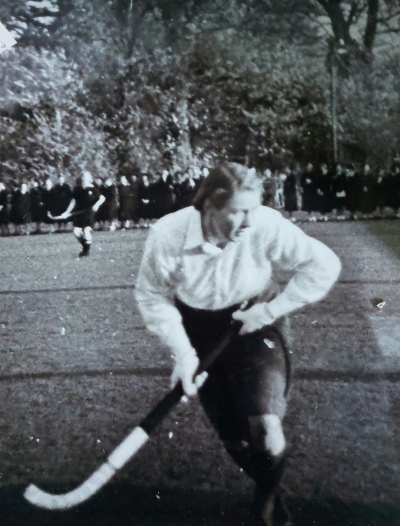
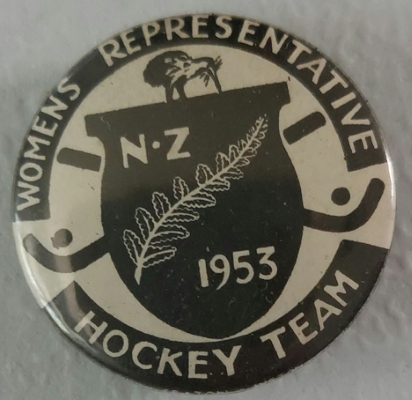
Image credits: Joy Crowther
Outside of sport, Joy has been heavily involved with environmental causes – an interest she has had since her days working on the land during the War. She chaired the Berkshire Environmental Association for 30 years and has grown many fruit trees – winning prizes for her apples and pears.
Joy celebrated her 100th birthday on 8th August 2025, surrounded by family and friends and she shows no signs of stopping anytime soon.
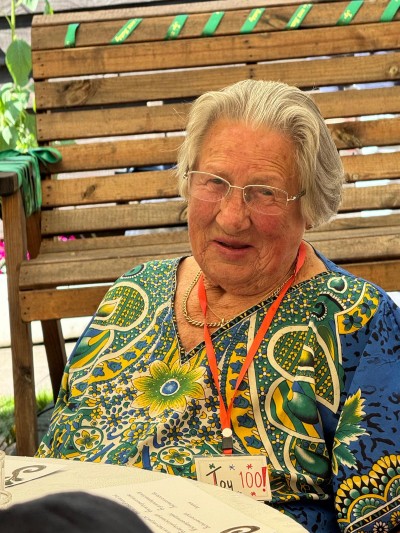
Image credit: Joy Crowther
Then and now – Joy’s memories of athletics
Athletics was completely amateur in the era that Joy competed. There was no prize money and certainly no contracts. Training was done around work – in Joy’s case teaching – as were competitions. Women’s athletics was managed by the Women’s Amateur Athletic Association who oversaw clubs and competitions – all on an honorary basis.
Technology was completely different – Joy recalls training on grass tracks usually at recreation grounds in her early years; “You were expected to run good quality in your plimsols on grass.”
Joy had a pair of shoes specially made for competing: “I was not getting a good footing on my throwing action in regular plimsols. I went to G.T. Law & Sons of Wimbledon and was measured in bare feet. They would make a trial shoe and then if it fitted would make up the whole shoe in kangaroo skin.
All field athletes had spikes in the heels of their shoes. I had one single spike in the heel of my left shoe so that I could rotate in the throwing circle. Law built shoes with real steel spikes in the soles.”
By the time Joy was competing surfaces were cinder, however this posed something of a problem for throwing: “the cinder surfaces would become loose after a few people had thrown, the stewards would tamp it down with weights, but you had to ask.”
“On the track you could dig little holes with a trowel to push off to give a better start in sprints”. Joy recalls her father building her first set of starting blocks out of timber; they had 6 inch nails in the bottom of them to secure them to the track – for relays a steward would have to quickly remove them after the start and smooth the track before the fourth leg athlete came down the home straight.
All jumps were done into sand – not just long jump and triple jump. “The landings for high jump and pole vault were nothing like today’s landings. The sand was a very heavy type of builders sand, and often very damp.”
All timing was done on stop watches – one person per athlete on the track. No transponders or photo finishes.
With thanks to Joy Crowther for sharing her memories, to Joy’s family,
and to The Hockey Museum for facilitating.